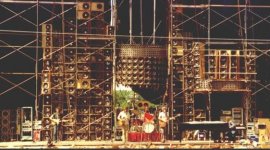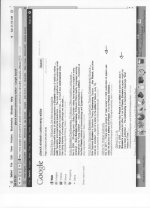SY, I was wondering when you would respond. SY and I have philosophical differences as to the actual 'history of science'. His view appears to be, even back as far as Galileo, that the 'authorities' at the time were wise and reasonable, and 'stories' about their resistance to new ideas is a fiction.
John, you're entitled to your opinions, but you are not entitled to lie about me.
Yikes! Huge PA behind the band. Sure glad I didn't have to run FOH or even monitors on that one.This is another 'Wall of Sound' than the GD. This is the GD version:
John, you're entitled to your opinions, but you are not entitled to lie about me.
Actually that was another of the Supreme Court's decisions! He is too.
That's what the differential mics allow.Yikes! Huge PA behind the band. Sure glad I didn't have to run FOH or even monitors on that one.
The most innovative part of that whole setup.
It never ceases to amaze me that when I try to present my position on something, such as the 'history of scientific discovery', I am constantly 'corrected' by SY. This has happened more than a few times, and it 'implies' that I am 'reckless with the truth'. No, I just have a different point-of-view.
To be clear, I have just tried to point out the difference in opinion that SY and I share about scientific 'authority', not to make up something about our differences. What I stated is 'true' to the best of my knowledge and experience.
To be clear, I have just tried to point out the difference in opinion that SY and I share about scientific 'authority', not to make up something about our differences. What I stated is 'true' to the best of my knowledge and experience.
John, what I quoted above from your post was not a difference of opinion. You attribute things to me that I never said. That is lying. Don't do that, it makes you appear dishonest as well as woefully ignorant of history. The latter is fine, most people are, and get their history from comic books and vaguely remembered elementary school classes. The former is unacceptable.
Yeah, I remember the differential mics - a very clever kludge. Putting the PA in front of the mics works better.That's what the differential mics allow. .
Yeah, I remember the differential mics - a very clever kludge. Putting the PA in front of the mics works better.
Also making flat frequency response is further improvement.
I'd think that you'd sing right in between them ......We used matched B&K 1/2" 4133 differential mike capsules that were flat to 40KHz. We did have some low frequency problems, however, due to the spill-over at low frequencies. You are supposed to sing into only 1 mike, and ignore the other.
You cancel out, if you sing right between them. I saw it in action, with a guest performer, once.
Hmmmm ....
I'm missing something .
Who engineered that aspect of the 'wall' ?
To minimize confusion about the design philosophy of the GD 'Wall of Sound' I will explain it here:
About 40 years ago, we decided to rebuild the GD PA system. Up to then, it consisted of a more typical PA system, with the speakers located to the very sides of the stage and as forward as possible, and the system was much smaller, because everything above 1 KHz was done by JBL horns. So we had a vertical stack of 15's that went to maybe 250-300 Hz, a stack of 12's that went to 1K or so, and then paralleled arrays of JBL horns (4 per side) that did the rest. It was all driven by McIntosh tube electronics, either 350W or 75W (for the horns). It was not a very small system, and it took hours to set up, with maybe 3 people, minimum. Of course there were the separate speaker stacks for the guitars and bass, that could be located behind the band, because feedback was not as likely, and we used conventional Shure or EV directional mikes for the most part. This is what the GD used from 1969 (or so) through 1972.
I was asked to evaluate the existing system, because the GD was not completely happy with it. The first thing that I did was to measure the horns, as to how much throat distortion they were putting out in an actual performance. I did this measurement just before a performance at the Berkeley Community Theatre, with an oscillator and a wave analyzer, and guess what I got? 3% distortion at 2W in per horn at 1KHz (this being the lowest freq of interest). Of course, it got worse on peaks, and at higher frequencies. I compared what I measured to the Olsen and Beranek reference formulas and graphs, and found that they tracked.
What to do? That means that we have 3% or more distortion from just one source, horn throat distortion, and so we decided to remove the horns and replace them with something else. More cones meant more surface area, and we could not easily put them just on the sides. What to do?
Well, Bear (Owsley) made a case for differential subtraction microphones that could discriminate between the NEAR FIELD (singers voice) and the FAR FIELD (the PA speakers). If it could be made to work, we could put the PA speakers BEHIND the vocalist's, rather than to the front-side that mostly kept feedback from happening. Then we could eliminate the usual monitors that FACED the band members, because they would get the bottom 1/3 of the stack behind them instead, in order to hear the PA. I thought it was NUTS. Why? Because I was a traditional audio engineer, and I did not believe that anything like this was probably possible or practical. However, it was their money, and Bear was in charge of the project.
We got started. We selected B&K 1/2" condenser microphone capsules, because of their flat response to 40KHz, AND their precision, so that we could get a good differential cancellation of the far field, (at least in theory). We had the money, we wanted the best, and so we did it. Amazingly enough, it worked, especially if the vocalist sang into ONE mike and not between the two mikes. This limited bringing a guest performer on stage, without orientation about the mikes. In any case, we built the 'Wall of sound' in many configurations and it became a magnificent 'beast' that took many, many crew members for set-up, take down, and transportation between 'gigs'.
I was told that this was what finally put the sound system out of business, too many hassles with the extended 'crew' of perhaps 100 people (including hangers on). The GD just got tired of the hassle, and 'retired'. Letting most of these people go as gently as they could.
When they decided to start up again, they started working with John Meyer, and his excellent horn loaded designs, that far exceeded the JBL's that were originally used, and they did a more conventional set-up until their breakup, almost 20 years later.
About 40 years ago, we decided to rebuild the GD PA system. Up to then, it consisted of a more typical PA system, with the speakers located to the very sides of the stage and as forward as possible, and the system was much smaller, because everything above 1 KHz was done by JBL horns. So we had a vertical stack of 15's that went to maybe 250-300 Hz, a stack of 12's that went to 1K or so, and then paralleled arrays of JBL horns (4 per side) that did the rest. It was all driven by McIntosh tube electronics, either 350W or 75W (for the horns). It was not a very small system, and it took hours to set up, with maybe 3 people, minimum. Of course there were the separate speaker stacks for the guitars and bass, that could be located behind the band, because feedback was not as likely, and we used conventional Shure or EV directional mikes for the most part. This is what the GD used from 1969 (or so) through 1972.
I was asked to evaluate the existing system, because the GD was not completely happy with it. The first thing that I did was to measure the horns, as to how much throat distortion they were putting out in an actual performance. I did this measurement just before a performance at the Berkeley Community Theatre, with an oscillator and a wave analyzer, and guess what I got? 3% distortion at 2W in per horn at 1KHz (this being the lowest freq of interest). Of course, it got worse on peaks, and at higher frequencies. I compared what I measured to the Olsen and Beranek reference formulas and graphs, and found that they tracked.
What to do? That means that we have 3% or more distortion from just one source, horn throat distortion, and so we decided to remove the horns and replace them with something else. More cones meant more surface area, and we could not easily put them just on the sides. What to do?
Well, Bear (Owsley) made a case for differential subtraction microphones that could discriminate between the NEAR FIELD (singers voice) and the FAR FIELD (the PA speakers). If it could be made to work, we could put the PA speakers BEHIND the vocalist's, rather than to the front-side that mostly kept feedback from happening. Then we could eliminate the usual monitors that FACED the band members, because they would get the bottom 1/3 of the stack behind them instead, in order to hear the PA. I thought it was NUTS. Why? Because I was a traditional audio engineer, and I did not believe that anything like this was probably possible or practical. However, it was their money, and Bear was in charge of the project.
We got started. We selected B&K 1/2" condenser microphone capsules, because of their flat response to 40KHz, AND their precision, so that we could get a good differential cancellation of the far field, (at least in theory). We had the money, we wanted the best, and so we did it. Amazingly enough, it worked, especially if the vocalist sang into ONE mike and not between the two mikes. This limited bringing a guest performer on stage, without orientation about the mikes. In any case, we built the 'Wall of sound' in many configurations and it became a magnificent 'beast' that took many, many crew members for set-up, take down, and transportation between 'gigs'.
I was told that this was what finally put the sound system out of business, too many hassles with the extended 'crew' of perhaps 100 people (including hangers on). The GD just got tired of the hassle, and 'retired'. Letting most of these people go as gently as they could.
When they decided to start up again, they started working with John Meyer, and his excellent horn loaded designs, that far exceeded the JBL's that were originally used, and they did a more conventional set-up until their breakup, almost 20 years later.
- Status
- Not open for further replies.
- Home
- Member Areas
- The Lounge
- John Curl's Blowtorch preamplifier part II

